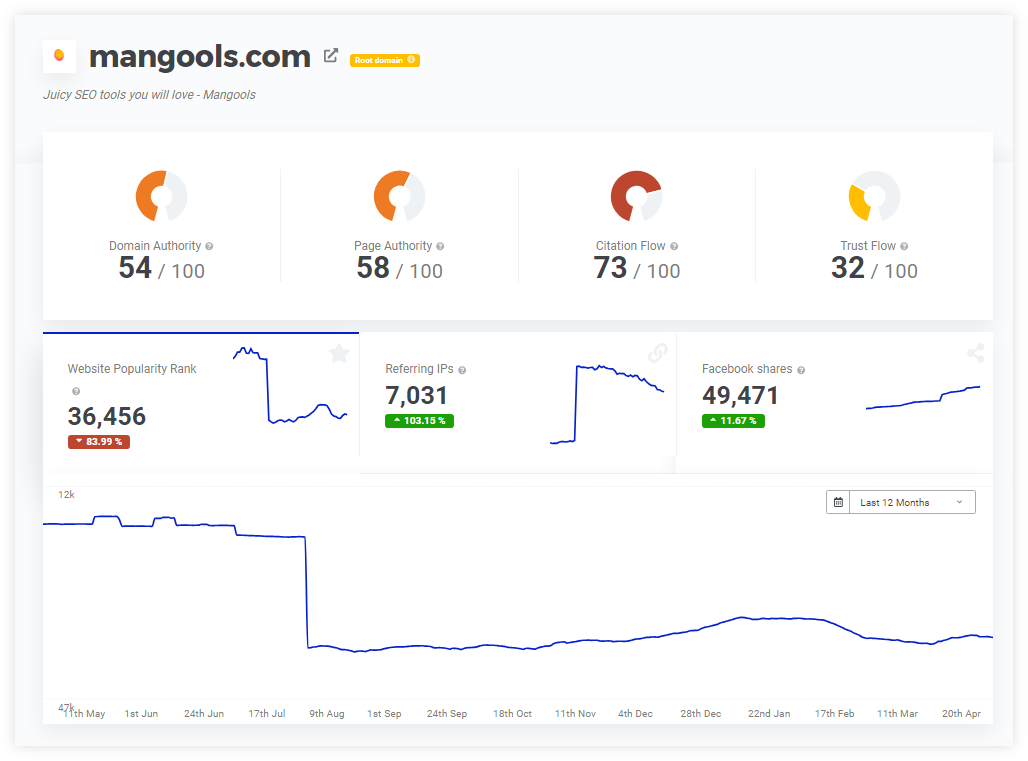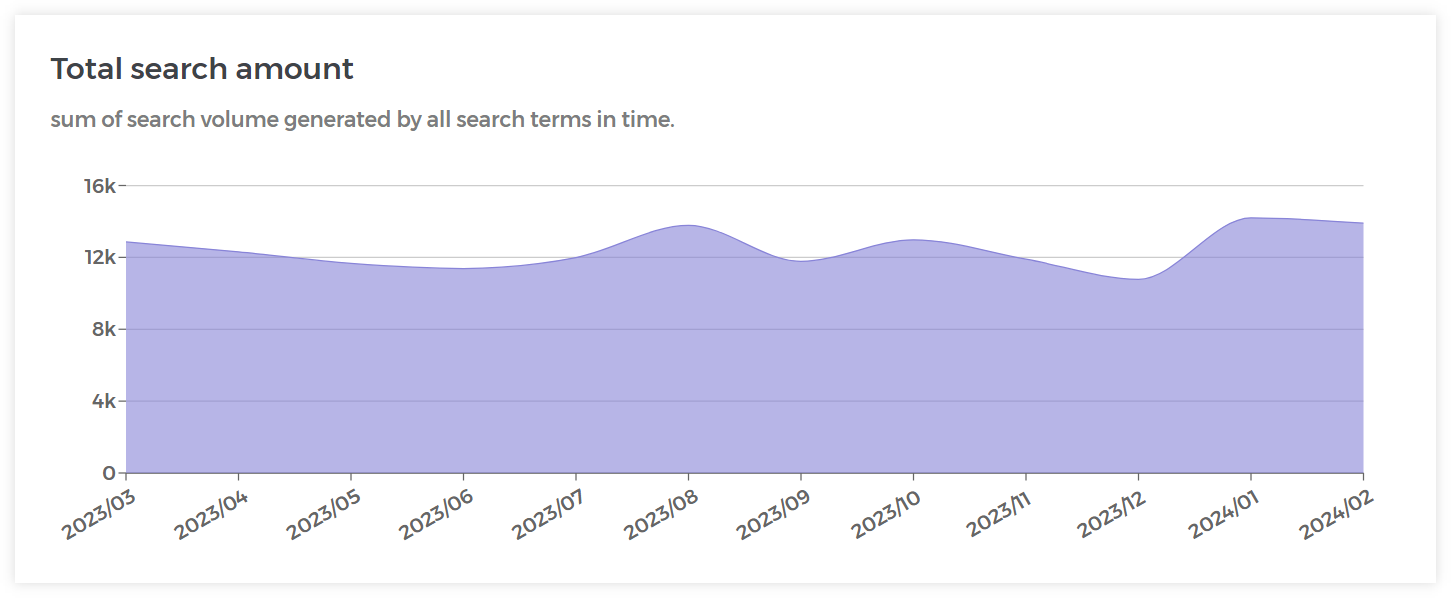Let’s face it – the Internet is crowded!
There are millions upon millions of businesses and people trying to grab your virtual attention each and every day.
Amidst this noise, understanding how much of the conversation you dominate compared to competitors is important in shaping your marketing strategy.
This metric, known as Share of Voice (SoV), offers a quantifiable answer to the question of how aware your audience is of your brand, and how much influence you have.
In this article, we will therefore take a look at:
- What is share of voice?
- Why is share of voice important?
- How to calculate share of voice?
- Best share of voice tools
- How to increase share of voice?
- Frequently asked questions
What is share of voice?
Share of Voice (SoV) measures the proportion of a brand’s visibility and awareness within a given market or industry across multiple channels, relative to all of its competitors.
Picture a crowded room where each brand’s voice competes for attention. SoV determines how loudly your brand speaks within that room.
For instance, if your brand is mentioned more frequently on Instagram or Facebook compared to your competitors, you likely have a larger SoV within that medium.
Share of voice vs. share of market vs. share of search
There are lots of ‘share’ terms bouncing around. These are the main differences between the 3:
- Share of Voice: Focuses on a brand’s visibility and dominance in conversations across various online channels.
- Share of Market: Reflects a brand’s share of revenue and conversions compared to the overall number of sales in the industry.
- Share of Search: Measures the number of organic searches for a specific brand in Google Search relative to the overall search volumes for all other brands in the industry.
Why is share of voice important?
SoV matters for online marketing because it provides a tangible measure of your brand’s presence and its strength within the online world.
When you want to quantify the extent to which your brand is being heard compared to your competitors, calculating SoV shows real data about your visibility, influence, and competitiveness.
This understanding is essential for strategic decision-making, resource allocation, and campaign optimization, which then help you effectively navigate and succeed.
Let’s take a look at the importance of SoV a little bit more.
a) Insights about your audience and competitors
SoV lets you know how your brand is perceived in comparison to its competitors.
Understanding the extent of your presence in the market conversation provides deeper knowledge of your audience’s preferences and behaviors, as well as a sneak peek into competitor strategies.
b) More brand awareness
A higher share of voice indicates more visibility and awareness among your target audience.
Actively participating in relevant conversations and increasing your presence across various channels effectively boosts brand recognition and recall among your audience.
c) Improved share of search
SoV correlates with the share of searches, indicating the proportion of online search queries related to your brand or products.
Increasing your share of voice through strategic marketing can also improve your share of search, leading to higher organic searches, traffic and potential customer acquisition.
d) Increased market share
A strong share of voice often translates to a larger market share.
Consistently outperforming competitors in terms of brand presence and engagement can attract more customers and gain more share of the market.
e) Better tracking and campaign analysis
SoV provides valuable metrics for tracking marketing campaign performance.
Monitoring changes in the share of voice over time and analyzing the impact of different strategies lets you refine your approach, optimize resource allocation, and improve overall campaign effectiveness.
How is share of voice calculated?
Share of voice can be calculated as the value of the chosen brand’s metric in a given platform, divided by the combined value of the given metric for all brands in the industry. The result can be then multiplied by 100 to get the percentage SoV value.
Formula: Share of voice = (Value of the selected metric for your brand ÷ Combined value of the selected metric for all brands in the industry) × 100
So for example, let’s say that we decide to choose the brands mentions in social media conversations as our metric.
If brand A is mentioned 200 times on social media and brands B, C, and D have brands mentions of 100 each, the share of voice for the brand A would be 40%.
Example: Share of voice = 200 ÷ (200 + 100 + 100 + 100) × 100 = 40%
Share of voice can be calculated differently for each digital medium, depending on the specific metrics relevant to that channel.
Share of voice for SEO
The formula for calculating SoV for SEO involves comparing the brand’s performance metrics to those of its competitors.
One way to calculate it is by dividing the brand’s total organic traffic or impressions by the total organic traffic or impressions of all competitors in the market and then multiplying by 100 to get the percentage.
You can also use other metrics to evaluate the share of voice from the SEO perspective, such as:
Another useful method how to estimate your share of voice is to use Mangools SERPWatcher – our tool can help you evaluate and compare the actual ranking performance of your website with the sites of your competitors in Google Search.
SERPWatcher provides 2 important metrics that can help you evaluate your SoV:
- Performance Index – It measures and evaluates website rankings based on the current positions of your tracked keywords and their search volumes.
- Visibility Index – It shows the visual dominance of your domain in Google SERPs based on your tracked keywords.
With these 2 metrics in mind, you can start tracking the most important keywords in your niche and compare the ranking performance and visibility for the same keywords between your website and the websites of your competitors.
Share of voice for PPC
For PPC, the formula for calculating SoV involves comparing your PPC metrics to competitors (notice a trend yet?).
It can be calculated by dividing the brand’s total ad impressions, clicks, or revenue by the total ad impressions, clicks, or revenue of all competitors in the market and then multiplying by 100 to get a percentage.
Share of voice for social media
On social media platforms, SoV can be calculated by looking at engagement metrics.
It involves comparing the brand’s social media presence (e.g., mentions, hashtags, post reach) to those of competitors.
You measure and evaluate various metrics, such as:
- Hashtags
- Mentions
- Post reach
- Likes
- Shares
Share of voice for media & PR
For media and PR, SoV can be calculated by comparing the brand’s media mentions and coverage to competitors.
This involves analyzing the brand’s presence across various media channels and platforms and using metrics such as:
- Media mentions
- Coverage in blogs, magazines, external websites, podcasts, etc.
Top 10 share of voice tools
Calculating SoV on your own can be quite time-consuming!
That’s why there are services dedicated to doing all the math and analysis for you, including many market research companies in US that specialize in providing detailed consumer insights and media analytics to streamline the process.
Here are the top 10 tools that you can utilize for share-of-voice calculations:
- Talkwalker
- Brandwatch
- Mangools SiteProfiler
- Hootsuite
- Awario
- Social Searcher
- Mangools Share of Search tool
- Mention
- Sprout Social
- Google Ads
1. Talkwalker
Talkwalker is a leading consumer intelligence company, offering a platform that drives business impact and revenue.
It provides a wide range of internal and external data sources, powered by AI technology called Blue Silk™, to give brands a well-rounded view of their consumers.
- Social listening: Monitor social conversations about your brand, products, and campaigns across platforms, online and offline. Understand consumer engagement with your brand and products.
- Image recognition: Identify brand mentions in videos and images, even without accompanying text. Gain insights into how consumers interact with your brand visually.
- Blue Silk™ AI: This technology enriches and categorizes data quickly, surfacing actionable recommendations. It makes social listening easier, faster, and more accessible.
2. Brandwatch
Brandwatch is renowned for its expertise in social media, offering a full range of solutions, ranging from market research to crisis management.
Brandwatch has been a hallmark in monitoring social media, news, and blogs since 2007, providing brands with an in-depth look into public sentiment and perceptions about users’ businesses.
- Crisis management: Get on top of problems before they spread by monitoring mentions and receiving alerts.
- Influencer marketing: Expand your brand’s reach with ad campaigns, discover relevant influencers, and manage relationships with ease.
- Consumer intelligence: Track performance across channels and get suggestions to drive data-driven decisions and optimize your social media strategy.
3. Mangools SiteProfiler
Mangools SiteProfiler is a free domain authority checker that can help you better estimate your share of voice from the SEO perspective.
You can check an array of powerful SEO metrics and get a better overview of your SoV in Google Search.
Once you enter your domain into the SiteProfiler, you can start analyzing multiple metrics and use them as SoV benchmarks, such as:
- Domain/Page Authority
- Citation/Trust Flow
- Website Popularity Rank
- Referring IPs
- Facebook shares
With Mangools SiteProfiler, you can also evaluate the authority of your competitors, export all the accumulated data. and begin comparing the SoV ratio between your website and those of your competitors.
4. Hootsuite
Hootsuite is your go-to solution for streamlining your social media management tasks and maximizing your brand’s presence online.
- Publish and schedule: Create and schedule your social media posts, and plan your content calendar.
- Engage customers: Manage incoming messages and interactions from various social channels within a single interface.
- Monitor activity: Stay ahead of the curve by monitoring market trends and keeping tabs on your competitors’ social media activities.
5. Awario
Awario offers social media monitoring tools to track brand mentions, monitor competitor activity, and analyze sentiment trends in real time.
- Monitoring: You’ll be the first to know about conversations that matter. React promptly to potential business impacts and gain an edge over competitors.
- Analysis: Track mention growth, analyze sentiment, identify top influencers, and compare alerts.
- Reach: Instantly gauge conversation impact, sorting mentions to focus on high-reach discussions and maximize your marketing efforts.
6. Social Searcher
Social Searcher provides real-time social media search and monitoring capabilities, allowing users to track brand mentions and monitor trending topics across various social platforms.
- Mentions: The tool Looks through 12 sources to find any mentions of your query and displays them, along with the total number of mentions and a sentiment score.
- Users and trends: Works similarly to Mentions, and provides the data you need to find users and track trends.
- Email alerts and detailed stats: Sign you for the ability to receive email alerts, export data, and get more thorough reports.
7. Mangools Share of Search
Mangools Share of Search is a free online tool that can help you check and compare the search volumes of branded keywords within Google Search.
You can simply enter branded keywords of your website and the websites of your competitors and see what is your overall share of search in your niche.
Besides the precise search volumes of branded keywords, you can check the combined search volumes of all brands in your industry.
From the SoV perspective, this is a perfect addition for any broader marketing evaluations since you will be able to check over time how the share of voice increase/decrease impacts your presence in Google Search.
8. Mention
Mention provides real-time media monitoring tools to track brand mentions across social media, news sites, blogs, and forums, enabling users to monitor brand sentiment and analyze competitive activity.
- Monitoring: Mention provides real-time alerts whenever your keywords are mentioned online, ensuring that you stay up-to-date with the latest conversations happening across various platforms.
- Social media listening: Watch for mentions not only on traditional websites but also on social media platforms.
- Analysis: Track your competitors’ mentions and see how their share of voice compares to yours.
9. Sprout Social
Sprout Social offers social media management and analytics solutions, allowing users to schedule posts, engage with audiences, and measure campaign performance across various social platforms.
- Manage social media: Tools to help you effectively manage your social media accounts. From scheduling posts to engaging with your audience, Sprout Social simplifies the process, allowing you to focus on creating compelling content.
- Drive more sales: Access product and customer information in one centralized location and sell more efficiently by understanding your audience’s preferences and behavior.
- Gather intelligence: Get large-scale data to help inform your social media strategy.
10. Google Ads
Google Ads offers plenty of advertising solutions made to boost brand visibility across Google’s search and display networks, which help with campaign management and SoV measurement in paid search results.
- Campaign management tools: Provides strong tools for creating, optimizing, and tracking advertising campaigns.
- Keyword targeting options: Take advantage of advanced keyword targeting options to reach relevant audiences based on their search intent.
- Ad performance tracking: Google Ads offers comprehensive ad performance tracking capabilities, allowing advertisers to monitor the effectiveness of their campaigns and measure ROI.
How to increase share of voice?
While tools can help in many ways, you’ll still need to put in some elbow grease on your own if you want to improve your SoV.
Here are actionable tips to help you increase your SoV and outshine competitors.
1. Create high-quality & shareable content
A surefire way to get people talking is to make high-quality content that people will want to read (or watch) and share.
Produce informative, entertaining, and visually appealing content that hits home with your target audience.
The goal is to encourage social sharing by making content that provides value and sparks conversations.
2. Engage on social media
As it’s called share of voice, it’s important to be an active participant on social media platforms – it’s vital for expanding your brand’s reach and influence.
Regularly engage with your audience by responding to comments, addressing inquiries, and sharing relevant content.
Join industry conversations, jump in on trending topics, and establish your brand as a thought leader in your niche.
3. Improve your rankings
Getting your search engine rankings up is a major part of increasing your SoV.
Focus on optimizing your website for relevant keywords, improving site speed and performance, and earning high-quality backlinks from authoritative sources.
Regularly monitor your SEO metrics and adjust your strategy to align with algorithm updates and industry trends.
4. Boost your SERP visibility & coverage
Maximize your presence in search engine results pages (SERPs) by optimizing your content for featured snippets, knowledge panels, and other rich snippets.
Aim to secure top positions for target keywords and phrases to increase visibility and drive organic traffic to your website.
Make sure to incorporate schema markup and structured data to enhance the appearance of your listings in search results.
5. Get positive reviews & testimonials
Good reviews and testimonials play a significant role in shaping consumer perceptions and influencing purchase decisions.
You can encourage satisfied customers to leave reviews on platforms like Google My Business, Yelp, and industry-specific review sites.
6. Focus on Surround Sound SEO
This is just a way of saying “have a well-rounded and multi-faceted approach”, and make your digital voice boom like an IMAX theater.
Expand your brand’s online presence by securing mentions and citations on reputable websites and publications. Collaborate with influencers, industry experts, and media outlets to generate buzz and increase brand awareness.
You can also set up guest blogging opportunities, contribute to relevant forums and communities, and participate in industry events to amplify your brand’s reach and influence.
7. Obtain valuable backlinks
It helps when others are talking about your brand – earn high-quality backlinks from authoritative websites and domains to improve your website’s authority and credibility.
Focus on building relationships with influencers, journalists, and industry leaders who can help promote your content and attract natural backlinks.
8. Start cold outreach
Initiate outreach campaigns to connect with potential partners, collaborators, and industry influencers who can help amplify your brand’s message and reach.
Additionally, be sure to personalize your outreach efforts, provide value upfront, and establish mutually beneficial relationships.
Tip: Before you start any cold email campaigns, make your inbox ready to send messages without being sent to the spam folder with an email warmup service such as Warmup Inbox.
9. Increase your advertising budget
Not seeing results? You might need to widen your advertising budget to expand your reach and visibility through paid channels.
Think about investing in targeted advertising campaigns on platforms like Google Ads, Facebook Ads, and LinkedIn Ads to reach specific audience segments and drive qualified traffic to your website.
Be sure to monitor campaign performance closely, optimize ad creatives and targeting parameters, and divert your budget towards high-performing channels and campaigns.
“Share of Voice” – new cartoon and post on marketing metrics https://t.co/NvSzfqe0Au#marketing #cartoon #marketoon pic.twitter.com/E3pr33EoBk
— Tom Fishburne (@tomfishburne) September 12, 2021
10. Respond to your audience and customers
Finally, prioritize customer engagement and satisfaction by actively listening to feedback, addressing inquiries, and resolving issues in a timely manner.
It’s important to foster open communication channels with your audience through social media, email, and other customer support channels.
Being part of the conversation goes a long way in making your voice heard!
Frequently asked questions
What does SoV stand for?
SoV stands for Share of Voice. It refers to the percentage of the total conversation or discussion within a specific market or industry that a particular brand or entity occupies.
What is the SoV rate?
SoV rate is the measurement of a brand’s presence or visibility relative to its competitors in a given market. It is often expressed as a percentage and indicates the brand’s share of the total conversation or discussion within that market.
What is a good share of voice percentage?
The ideal share of voice percentage varies depending on factors such as the industry, market dynamics, and competitive landscape.
Generally, a higher share of voice percentage indicates greater brand visibility and influence within a market.
However, the specific target percentage may differ based on individual business goals and objectives.
What is the difference between Share of Voice vs. Share of Market?
Share of Voice (SoV) measures a brand’s visibility or presence within a specific market based on its share of the total conversation or discussion.
Share of Market (SoM), on the other hand, refers to a brand’s share of the total market sales or revenue.
While SoV focuses on brand visibility and influence, SoM evaluates market share in terms of financial performance.
What metrics can be used for the SoV calculation?
Various metrics can be used to calculate Share of Voice (SoV) across different channels and mediums. Some common metrics include:
- Number of brand mentions or references
- Volume of social media interactions (likes, shares, comments)
- Website traffic and search engine rankings
- Impressions and clicks in paid advertising campaigns
- Media mentions and coverage.









